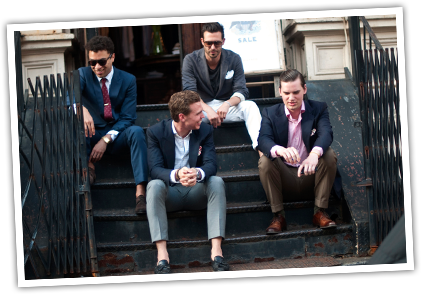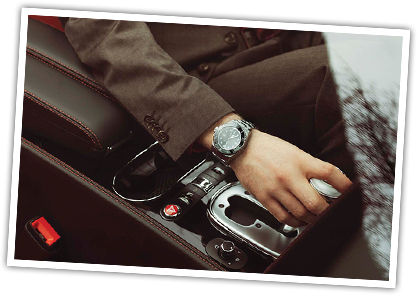The summer of 2000 was surely a high point for Calvin Lui. He was CEO of a hot startup that had just raised $17 million from Highland Capital and secured a premier distribution deal with AOL, putting his company's product directly in front of the Internet service provider's 22 million members through prominent featured placements on AOL.com, CompuServe, Shop@AOL and Spinner.
The partnership made sense for both parties at the time. Reports from Jupiter Communications and Ernst & Young released that year showed that men represented the single largest demographic of online users and shoppers, and Lui's business held a coveted first-mover advantage catering to this coveted segment.
But the momentum of that summer was shockingly short lived. On Nov. 1, 2000, TheMan.com, self-described in press releases as "the premier solutions retailer for today's successful man ... leverag[ing] expert content, sophisticated merchandise and convenient personalization services" announced it was bankrupt and shutting down — a mere 10 months after launching.
TheMan.com's phenomenal rise and equally spectacular fall is a familiar tale from the archives of the dot-com bubble burst, not to mention a high-profile false start for the men's lifestyle industry in the race to transition online. What went wrong isn't entirely clear, though the typical symptoms of drunk-on-optimism thinking were certainly there — exemplified by a rumored $3 million Times Square billboard. Still, looking back on the situation and knowing the state of men's media online today, it's hard to shake the idea that Lui's company was just a dream slightly ahead of its time.
The Missing Link
Whether or not Lui's fantastic misfire had anything to do with it, there's no denying that the men's lifestyle vertical took longer to incubate digitally than its fairer-sex counterparts or other topics known for amassing male eyeballs like automotive, technology and sports.
While in the mid-2000s AOL was buying upstart digital media companies, including Weblogs Inc. — headlined by flagship blogs-turned-brands Engadget and Autoblog, — for an estimated $25 million, the race to create the next generation of men's media was just getting started. (Askmen.com, which was purchased by Fox's IGN in 2005 before eventually being sold to Ziff Davis, deserves credit as the one notable exception to the trend).
UrbanDaddy and Thrillist quickly proved email was still a potent medium for keeping men informed about cultural and local happenings; style authorities such as Hypebeast and Highsnobiety began catering to a new generation of guys inspired by global fashion and culture. Others such as Uncrate illustrated that focused curation alone could provide value for a modern man exposed to a widening fire hose of information and less time to graze.
Soon enough these startups were gathering male audiences that rivaled and quickly surpassed the circulation figures of their printed forebears. Their progress showed that there was still an opportunity to redefine the category online beyond the GQs and Esquires of the world, many of which, under the weight of publishing houses, were slow to fully embrace digital formats. Astonishingly, the reigning powers were leaving the inside lane for influencing the upcoming generation of discerning men wide open, and other enterprising media pioneers were finally ready to race.
Be Stylish, Authoritative, Funny, Knowledgeable, Adventurous and Multiply
The victories of these early entrepreneurs in the latter half of the "naughts" caused the vertical to expand faster than Kanye's ego (Gear Patrol launched in April 2007). Newcomers, seeing the value of owning a niche elsewhere on the Web, launched their own properties catering to specific types of men from the outset. It was a model that starkly contrasted with the original editorial mission laid out in the first edition of Esquire published in 1933: "to become the common denominator of masculine interests — to be all things to all men." The industry was finally delivering on the promise of the web, uniting male communities around their hyper-focused interests and obsessions — begging the question, what exactly is men’s media today?
Quora, the great and powerful, doesn't have a clear answer — neither does Siri. But the blurring lines shouldn’t bother brands or marketers. Finding the man of your dreams (or RFPs), is easier now than ever before, as long you know where to look. Breaking down the various factions vying for a slice of the male psyche today is certainly one helpful way to make sense of it all, but be cautious about leaning too heavily on this crutch. The Renaissance man is making a comeback, and the days of the mutually exclusive audience are over.



Mutation
or
Adaptation?
As much as the category has evolved to date, plenty of developing trends hint that the changes in the men's lifestyle vertical are far from over. In fact, history suggests it may just be coming full circle.
Today, in the shadow of sleek mastheads and celebrity covers, few remember that GQ began life in 1931 as Apparel Arts, a limited print publication aimed at men's fashion wholesale buyers and retail sellers. It was a resource designed to educate industry insiders on emerging trends so that they could, in turn, pass advice along to their customers during the shopping process. The information often intrigued retail customers who would take copies away from the store. The trend was noticed, and in 1933, Esquire launched in response. Apparel Arts still continued as is until 1957, when it was transformed into a quarterly magazine published by none other than Esquire. In 1958, the name of the revitalized mag was changed to Gentleman's Quarterly. The rest, as they say, is history.
Given many outlets' longstanding and growing editorial attention on products (Men's Journal launched the Gear Lab in 2012), the convergence of content and commerce is a tremendous opportunity for the industry. "How" that's best accomplished, however, still remains to be seen. The concept certainly isn't new — remember, retail was a core tent pole of even TheMan.com's business plan, — but recently, established players are helping validate the model. Thrillist acquired JackThreads in 2010, and Hypebeast followed suit by launching its own curated store in 2012. There have been serious missteps along the way too, such as Gilt's Park & Bond or Esquire's anvil in the deep fryer, Clad. The shift is bound to continue.
Crossovers coming from the other direction are even more fascinating: Online men's retailers are embracing roles as lifestyle advocates through content. The Journal, a weekly digital editorial enterprise from MR PORTER (the men's luxury arm of Net-a-Porter), is a widely respected example, proving that the path to capturing the male zeitgeist is no longer a one-way track to publishers.
As with other media verticals, commerce isn't the only form of brand extension being explored by digital-era outlets these days. Event hosting, brand consulting, product design collaboration, PR, print editions and even television (yes, Esquire's network is actually launching this time) are all being pursued by companies in search of additional and even mainline revenue streams — or in other cases, simply more prestige.
Men’s Media
Streetwear & urban
outdoor & adventure
food, drink, travel
the generalists
For some, the blurring lines surrounding men's media brands and their charismatic ambassadors have raised questions about conflicts of interest and editorial integrity. So far, audiences don't seem to care. Some might say it's a testament to the difference in ethical standards placed on lifestyle publications versus journalism. Maybe bros just give other bros the benefit of the doubt. What's more likely is that the trend simply speaks to the revival of old themes finally made infinitely more actionable, not to mention more trackable, by technology.
The bread-and-butter topics that have defined men's media over the past 80 years have always evolved with the times, reflecting whatever was implied by masculinity in that moment. But they've all been united by the same basic principal: that we can take ownership of our lives and that peers often make the best teachers. These tenets aren't going away anytime soon, no matter what the future holds for the industry. As men, we'll never pass on having things easier. Or housing something tastier. Or holding something shinier. Or honing something sharper. Or hacking something better. Or honoring something iconic. So it shouldn't surprise anyone that men's lifestyle business is bound to move in new directions. Men have always changed with the times; so should their media.
